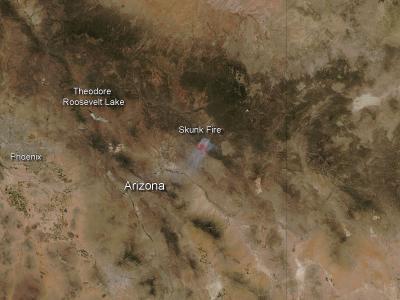The Skunk Fire in Arizona started with a lightning strike on Saturday, April 19. Currently over 10,000 acres have been affected. It is located in the San Carlos Apache Reservation. The terrain in the area is very steep with boulders making it difficult for firefighters to traverse the area to fight the fire. The fire continues to grow to the north, but fire activity in the south has been stopped. The fire is currently 20% contained.
The National Weather Service is forecasting winds of 7-12 mph with gusting to 25 mph. These conditions coupled with extremely dry fuels and low relative humidity will most likely result in increased fire activity.

The Skunk Fire in Arizona started with a lightning strike on Saturday, April 19. Currently over 10,000 acres have been affected. It is located in the San Carlos Apache Reservation. The terrain in the area is very steep with boulders making it difficult for firefighters to traverse the area to fight the fire. The fire continues to grow to the north, but fire activity in the south has been stopped. The fire is currently 20 percent contained.
The National Weather Service is forecasting winds of 7-12 mph with gusting to 25 mph. These conditions coupled with extremely dry fuels and low relative humidity will most likely result in increased fire activity.
(Photo Credit: NASA's Aqua satellite collected this natural-color image with the Moderate Resolution Imaging Spectroradiometer, MODIS, instrument on May 15, 2014. Actively burning areas, detected by MODIS's thermal bands, are outlined in red. NASA image courtesy Jeff Schmaltz LANCE/EOSDIS MODIS Rapid Response Team, GSFC. Caption by Lynn Jenner with information from Inciweb.org.)
NASA's Aqua satellite collected this natural-color image with the Moderate Resolution Imaging Spectroradiometer, MODIS, instrument on May 15, 2014. Actively burning areas, detected by MODIS's thermal bands, are outlined in red. NASA image courtesy Jeff Schmaltz LANCE/EOSDIS MODIS Rapid Response Team, GSFC. Caption by Lynn Jenner with information from Inciweb.org.
Source: NASA/Goddard Space Flight Center